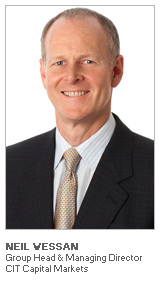
Equipment Finance Advisor recently spoke with Neil Wessan, Group Head and Managing Director of CIT’s Capital Markets Group, who shares his perspective on the current dynamics experienced within the marketplace.
With nearly 30 years in the industry, Wessan has held senior level positions with various financial institutions, including CIBC World Markets. Prior to CIT, Wessan served as head of Capital Markets for Gleacher & Company. Before that, he was a founding principal at Halsey Lane Holdings and served as managing director and co-head of Jefferies & Company’s Leveraged Loan Capital Markets and Syndications Group.
At CIT, Wessan’s group is responsible for the structuring, pricing and distribution of all financial products originated by CIT. His group of senior bankers possesses significant capital markets experience combined with a deep understanding of CIT’s industry verticals thereby enabling the team to provide a strong combination of industry expertise and capital markets know-how. The entire group, which is comprised of 17 professionals, is based in New York City.
Equipment Finance Advisor: How does CIT Capital Markets define the middle market?

Neil Wessan: We typically define the middle-market as companies with annual revenues of between $25 million and $1 billion. However from a deal perspective, that is companies that we typically finance, we view the middle market as those companies with EBITDA of between $10 million and $50 million. While this is our sweet spot, I would say that we often make an exception to this range on the equipment financing side. There might be certain types of equipment that we would be willing to finance, even if the company was below this range.
Equipment Finance Advisor: How would you describe the current lending environment?
Wessan: I would describe the current lending environment as "balanced." There are various pressures on the lending community and there are pressures on the issuing community, which together today are counteracting each other. This is creating opportunities for people to do well-priced and well-levered transactions. Overall though, the market remains quite competitive and while bank credit standards have not loosened, there are some non-banks who may have credit standards that are a bit looser as they are free from regulatory oversight.
The structures that are used in the middle market today are pretty much the same that we’ve been using over the last few years, some of them for decades. I think there’s greater precision in terms of when to use one type of structure versus another. We are seeing the bulk of transactions on a first lien and second lien basis and recently many more instances of unitranche financing. Unitranche is being used in transactions where time is of the essence or there is some time consideration where the private equity sponsor or issuer wants to just know that the deal will get done on an expedited basis.
Additionally we’re also seeing more of the asset-based loan and split term lien loan being used. It’s a very old structure, maybe the oldest of all these structures, and it’s finding a lot of efficiency because the ABL typically does not have many, if any, covenants. The split lien term loan that follows with it is somewhat covenant loose and as a result the issuer likes that structure. Additionally, the total cost of those structures can be very competitive, more competitive than the first lien/second lien deals.
Equipment Finance Advisor: Which industry sectors are performing well? As a follow up, has there been any pull back in the energy sector?
Wessan: We’re seeing a little more activity in healthcare and aviation, and across the field were seeing really good volume of inquiry. On the flipside, a sub sector of energy, which is in the oil and gas exploration and development side, has experienced some hesitancy in the market and I expect this area to be under some stress until oil prices stabilize. However, on the other side of energy, the power side for instance, we’re seeing a lot of activity and really good transactions. So within the overall general energy sector, things are okay.
Equipment Finance Advisor: Are there any new players participating in the capital markets space today? If so, what impact have they had?
Wessan: We are seeing some non-traditional players, non-banks, come into the market where banks believe the leverage might be too excessive, or the company may not have a long enough track record of operations. These non-banks are active in these arenas and are charging more because they can.
Equipment Finance Advisor: What’s the biggest difference in the way you approach the market than you did ten years ago?
Wessan: Ten years ago for certain types of financing like equipment financing, there were very specific and defined players that you could go to. Today that list has broadened beyond banks; you have insurance companies and funds that also play in these arenas.
Another difference is that lenders today are very concerned about regulatory oversight and its implications. I hear from a lot of accounts that the first question that gets asked when they're shown a loan is not whether it’s a good credit; not whether they like the sponsor and not whether they like the industry. Instead, the first question they ask is will this fit under our current regulatory regime and environment. It brings a new perspective to our marketplace.
Equipment Finance Advisor: Is there anything else you'd want to add?
Wessan: I would just say that CIT has been in this business for more than 100 years and we have a lot of expertise amongst our industry verticals, with specific asset and equipment type. We can be comfortable in areas that other people may not be because of our deep industry knowledge.